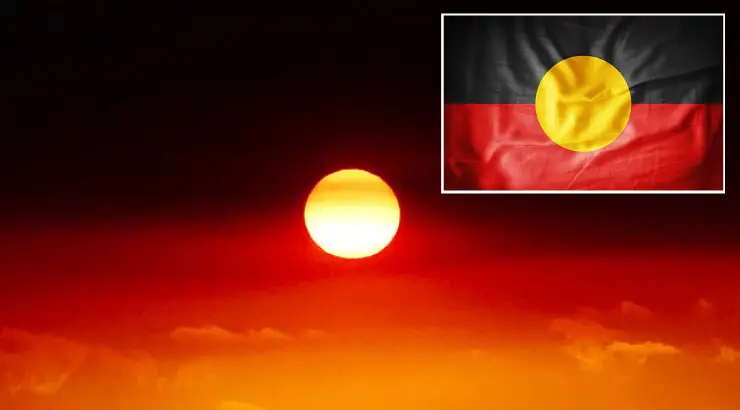 While Australia enters in 2020 in the middle of its worst fire crisis, an omen of hope appears in the sky. The country where conservatives won elections by promising to support the carbon economy is now on its knees under the blows of a fire crisis triggered by climate change. While in the red-tinted sky of the fires, Rose Fletcher, a resident of southern Australia, captured a new year's image of the sky resembling the Aboriginal flag. In the middle of the catastrophe, an omen for a world in harmony with nature.
While Australia enters in 2020 in the middle of its worst fire crisis, an omen of hope appears in the sky. The country where conservatives won elections by promising to support the carbon economy is now on its knees under the blows of a fire crisis triggered by climate change. While in the red-tinted sky of the fires, Rose Fletcher, a resident of southern Australia, captured a new year's image of the sky resembling the Aboriginal flag. In the middle of the catastrophe, an omen for a world in harmony with nature.Forest fires are not new in Australia. Indeed, some of its habitats need fire to be able to renew and stimulate germination, a natural system developed over millions of years. But climate change and drought crisis have caused massive violent fires that have wiped out life in an area larger than Switzerland. Nearly 500 million mammals, reptiles and birds—including 8,000 koalas—are estimated to have been killed, although the current death toll is impossible to calculate. The massive loss of life threatens to forever tip the balance for entire species of animals and plants on an island continent where 87 percent of wildlife is endemic to the country, meaning it can only be found on Australia.
As of Saturday, over 23 lives have been claimed by the deadly fire crisis, while many more people lost everything in the flames.
As Australia continues to suffer from a wave of fires unprecedented in its modern history, a number of hauntingly beautiful images have emerged showing the elemental force of nature at its most awe-inspiring and terrible. The most recent of these images is a photo of the apocalyptic skies in the country that bears a brilliant resemblance to the flag representing the indigenous population of Australia—or the Australian Aboriginal Flag.
The photo was taken by Rose Fletcher, a resident of southern Australia who captured it at Victor Harbour while the sun rose on New Year’s Day with ferocious fires burning nearby. “When this happened, I was feeling hopeless, all the fires, and there between the sunrise and me, a giant pall of smoke over the Southern Ocean – and then that few seconds I could capture.”
The photo was taken by Rose Fletcher, a resident of southern Australia who captured it at Victor Harbour while the sun rose on New Year’s Day with ferocious fires burning nearby. “When this happened, I was feeling hopeless, all the fires, and there between the sunrise and me, a giant pall of smoke over the Southern Ocean – and then that few seconds I could capture.”
“It was taken on New Year’s Day, just after sunrise, when the fires were arguably at their worst, and hearts were heavy and people were frightened—me included” she added.
The rising sun was just a pale disc behind the layers of smoke over the Southern Ocean—and then, for just a few magic seconds, as it moved up through successively dense layers, it formed the Aboriginal flag.”
Upon realizing how powerful the image was, she quickly went home to share it. She said:
The rising sun was just a pale disc behind the layers of smoke over the Southern Ocean—and then, for just a few magic seconds, as it moved up through successively dense layers, it formed the Aboriginal flag.”
Upon realizing how powerful the image was, she quickly went home to share it. She said:
The Australian Museum describes the Australian Aboriginal Flag as “divided horizontally into equal halves of black (top) and red (bottom), with a yellow circle in the center.”
The black in the flag represents the indigenous population of Australia, while the red represents the relationship between the earth and the original people of the continent. It also represents ochre, the naturally red clay used in Aboriginal ceremonies. The yellow at the center of the flag represents the sun its constant renewal of the earth.
The flag was designed by Harold Joseph Thomas, a Luritja indigenous man and celebrated Australian artist. It first flew at Victoria Square, Adelaide, on National Aborigines Day on 12 July 1971. The flag has been adopted by all Aboriginal groups in Australia.
The black in the flag represents the indigenous population of Australia, while the red represents the relationship between the earth and the original people of the continent. It also represents ochre, the naturally red clay used in Aboriginal ceremonies. The yellow at the center of the flag represents the sun its constant renewal of the earth.
The flag was designed by Harold Joseph Thomas, a Luritja indigenous man and celebrated Australian artist. It first flew at Victoria Square, Adelaide, on National Aborigines Day on 12 July 1971. The flag has been adopted by all Aboriginal groups in Australia.


